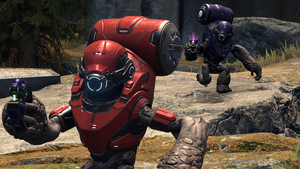| Unggoy Assault | |
|---|---|

| |
|
Function: |
Ground assault/infantry |
|
Species: |
|
|
Affiliation: |
|
|
Branch: |
|
Unggoy Assaults are a class of Unggoy that serve the Banished.[1]
Overview
Unggoy Assaults are essentially the equivalent of the Covenant's Unggoy Majors. They are slightly more heavily armored and somewhat more aggressive than the bottom-ranking Unggoy Conscripts. Like the Conscripts, Unggoy Assaults tend to panic and flee if they witness the deaths of their Sangheili or Jiralhanae officers. Also like the Conscripts, Assaults will occasionally turn suicidal, equipping two Anskum-pattern plasma grenades in a last ditch attempt to kill their opponents.
History
The Assault rank was specifically designed for direct application of combat forces against an enemy site or asset. Assault Unggoy are better armored than Conscripts because of a fully sealed helmet. Before Unggoy can join the Assault class they most go through a rigorous training exercise which was designed specifically to root out weakness in their ranks.[2] Numerous Unggoy Assaults fought for the Banished during the faction's occupation of Installation 07.
Equipment
Unggoy Assaults wear methane rebreathers that cover the entire head. Their methane tanks and combat harnesses are similar in design to the ones worn by Unggoy Imperials. Unggoy Assaults wearing red combat harnesses are commonly seen wielding Disruptors, while Assaults wearing purple combat harnesses carry Rohakadu-pattern plasma pistols. Both variants carry Anskum-pattern plasma grenades.
Gallery
| Browse more images in this article's gallery page. |
Concept art
Concept art exploration for the Unggoy Assault helmet for Halo Infinite.
Screenshots
An Unggoy Assault argues with his Jiralhanae superior aboard the Ghost of Gbraakon.
An Unggoy Assault and a Kig-Yar Sniper.
The corpse of a red Unggoy Assault with a Needler found on Warship Gbraakon.
List of appearances
- Halo Infinite (First appearance)
Sources
- ^ Megaconstrux, Grunt Assault (Retrieved on Jan 3, 2022) [archive]
- ^ Halo Encyclopedia (2022 edition), page 430
| ||||||||||||||
